It's been four years since Giovanni Trapattoni - the successful Italian football coach - helped the "empty bottle" achieve cult status: "What allow Strunz,... ware' weak as a bottle empty.... I'm done!"(http://www.youtube.com/watch?v=gCvRRFwBs3Y) Since then, the "empty bottle" has been used as a quote in all possible (and impossible) situations. In the case of wine, it is the bottle that is of fundamental importance. It shapes the image of the wine, is the cause of the most heated discussions, even actual religious wars, due to the indispensable closure, and finally, it is - provided with a label - also a status symbol.
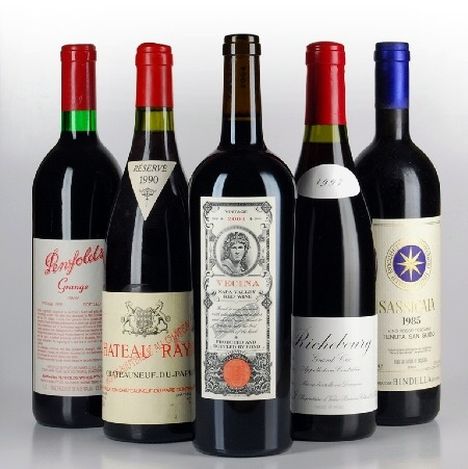 |
| Prestige wines at an auction% Wine Exchange 83-2012 (Photo: P. Züllig) |
Royal or poor man's wine is not put into a cradle, but packed into the appropriate bottle, bottled. The "fullness" is analysed, criticised, praised or fiercely rebuked, praised or condemned, even pressed into rankings, at all stages - whether young or old, whether calmly stored or exposed to fluctuations. The shell, on the other hand - although conspicuous and allegedly to blame for many evils - remains unmentioned and is - as soon as empty - usually disposed of in an environmentally friendly manner. Yet it has more (symbolic) power than we give it credit for.
 |
| Traditional wicker bottle "Fiasco" from Tuscany (Photo: P. Züllig) |
Most people are wine-socialised by the bottle and far less often by its contents. It is also an attribute of fashion and a commitment to a certain kind of wine consumption and enjoyment. For me, it was the demijohns from Tuscany, called "Fiasco", that first coined the term wine. I recently read in a cooking blog: "... I want to have an Italian party soon and I'm desperately looking for these beautiful demijohns of Chianti. I know, when I was a teenager, every second person brought a bottle like that to the fête (it wasn't expensive and it had a lot in it). Now after 25 years I wanted to buy these bottles partly for decoration and of course for drinking." So my reference to wine socialisation can't be all that off the mark. My "Fiaschi" soon disappeared from the table, however, and took their place as lamp stands in the student digs. Wine was poured into the glass from litre bottles - mostly from France or Algeria - but almost always with crown corks or screw caps.
It never occurred to me to drink "inferior" wine from them: the wine was good, cheap and corresponded to my taste in wine at the time. Then - on my first trip to Provence - I got to know the sale of wine "en vrac" - which we call bulk wine. Even today - especially in the south of France - wine shops - particularly in cooperatives - have large steel tanks from which customers fill wine into larger containers (bidons) - usually made of plastic - and very often transfer it into bottles at home. Today, quality wines (AOC) may no longer be sold in this way. Until the 1960s, "open" or "bulk" buying was still possible even in Burgundy and other prestigious wine regions - lucky for wine geeks. So for a long time I continued to "bottle my own" at home year after year and was proud of the quality that we - my friends and I - had found somewhere in the big wine world.
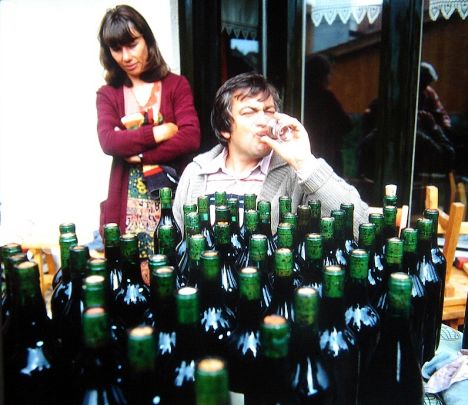 |
| Bottling - the beginning of my wine socialisation more than 30 years ago (Photo: P. Züllig) |
But the socialisation of wine through bottles continues; it is not yet finished today. Bottling "Vrac wines" brought me to the bottles in "Bordeaux form". Only they - because they have no bellies - could be stacked reasonably neatly lying down. So I started collecting empty Bordeaux bottles.
Another transformation in the way I deal with bottles has quietly taken place: The 0.75-litre bottle came on the table, outward sign of "wine connoisseurship". I would never have dared to open a litre bottle, even when I was at home. This quarter of a litre makes it to be at least "outwardly" a "decent wine". I have finally managed to be so wine-socialised that the labels - and no longer the bottle size and shape - define my understanding of wine.
And since word had already spread among my circle of friends about my collecting of empty Bordeaux bottles, Bordeaux - at least the bottle shape - became the defining norm. Automatically, Burgundy, belly and other bottles were ruled out. It has to be Bordeaux, otherwise my wine cellar gets confused. But it didn't stay with the empty bottles, gradually full ones were added - even "real" Bordeaux. And again, a quantum leap in my wine awareness set in: caraffing or decanting.
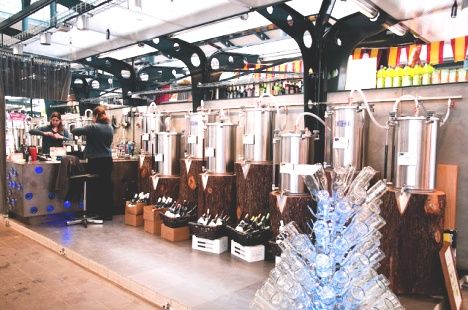 |
| Vin en Vrac (Photo: P. Züllig) |
Bottles no longer climbed my table. They were decanted beforehand - decanted - into carafes with the most whimsical, but also the most beautiful shapes. Again, the glass (and its shape) took on something like a guiding function. Particularly precious wines were presented in particularly elegant carafes, simpler wines in simpler ones. This went well until my friends caught me out. So from then on I could no longer put up "simpler" carafes.
But the real trouble with the bottles came - suddenly, about ten years ago - from a completely different source. At first it was clearly country-specific: Germany or Austria. Although I continued to steadfastly put out decanters (and not bottles), there was no longer any "nice" wine without a closure discussion: natural corks, plastic corks, glass corks, screw caps, crown caps... the different brands, the different types, the different designs. And since then, whenever I open a wine magazine, read a test report or visit a wine blog, I always encounter it, the bottle closure discussion. So the bottle - even the empty one - has caught up with me again. I now know with certainty: it is first and foremost about the bottle and only much later about the wine.
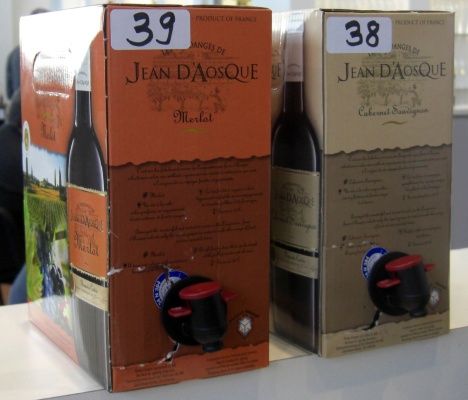 |
| "Château Karton" at the ProWein in Düsseldorf (Photo: P. Züllig) |
And again I had to deal with an almost "revolutionary" bottle substitute, the "Château Karton". Actually, I wanted to spare myself this, to stick to my Bordeaux bottles and to my decanters (there are now more than 30 - enough to mark quality levels). But my friends now - before wine went into the glass - almost always asked the Gretchen question: "How do you have it with the cardboard?" Actually, not at all, I wanted to say. But that answer didn't count. So I made an effort to find a new - contemporary - wine socialisation. It was difficult to find serious wines in the "Château Karton". At the huge ProWein trade fair in Düsseldorf, I found - among thousands - just two or three suppliers. Finally, I managed the social change in me after all. I find the cartons practical and usable, just not aesthetic. Filled with good wine, they are even a real alternative for wine drinkers who always have open bottles in the kitchen or in the fridge, which is hardly ever the case with me. So I stay with the bottles.
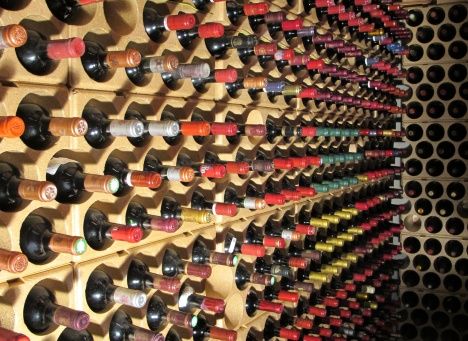 |
| My wine cellar% nicely organised (Photo: P. Züllig) |
The next hurdle I have brought upon myself. Again, the bottles are a stumbling block. I get to know and appreciate more and more wines from more and more wine regions. First it was the Burgundies. But the bottles did not fit well into my cellar, which was so practical for Bordeaux bottles. Then came peculiar special formats (with excellent contents), such as the Bocksbeutel from Franconia. Even worse, my friend the winegrower bottled his best wine in pot-bellied bottles that no longer fit at all into my elaborate cellar order. In addition, there were large formats: Magnum, double magnum, Jeroboam, Methuselah... right up to the Goliath. But the Piccolo or the "Halbe" also made their way into my cellar.
And then there was the disposal. The bottle containers in our village - as in most places - have three categories for empty bottles: white, green and brown. So often I find myself at a loss: What do I do with this darned blue bottle? Or: Is this a green, a brown or even a black bottle? I'm overwhelmed. The French have it easier. Bottles are simply bottles, whether they are green, white or brown: they go - if at all - into the container.
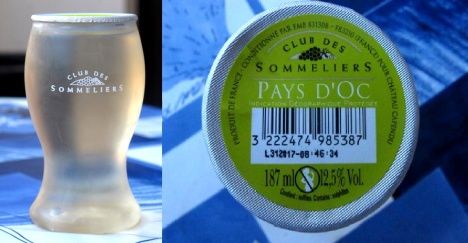 |
| Ready-to-drink (Photo: P. Züllig) |
Whoever now assumes ". I'm done", the bottle ordeal is coming to an end, I have to disappoint you. In a grocery shop I have now found the ultimate solution: the "glass wine". No, not the wine glass, I've known that for a long time (because I don't drink wine out of cups, mugs and goblets). But the "Club des Sommeliers" has created the "glass wine". A drinking glass - which in this case contains white wine. The closure is aluminium foil, the content 187 millilitres, 12.5 percent by volume, Pays d'Oc, Château Capendu (Corbières). "Ready-to-drink" is the name of the line: "The ideal solution for wine consumption at almost all outdoor events, picnics, fast-food... easy to open by peeling off a protective aluminium layer which perfectly preserves our wines. The 100% recyclable PET glass is unbreakable and guarantees perfect protection of the aromas." Advertising skilfully summed up in four terms: unbreakable, quality-conscious, recyclable and transparent. I admit, it sounds a bit more elegant in French: "incassable, recyclable, transparence, conservation + 12 moins". By the way: there is the "ready-to-drink" glass with red, rosé and white wine. Always with the guarantee: "The wines we put in our glasses are exactly the same as those we offer in the 75-cl bottles."
Is this now the farewell to the bottle? Did Giovanni Trapattoni recognise the situation early on? I don't know what the wine is like that was packed into the glass ready for purchase. I haven't drunk it yet. But this is not about the wine, about the fullness, it's about the wrapper: "...were' weak as a bottle empty.... I have finished!
Sincerely
Yours sincerely